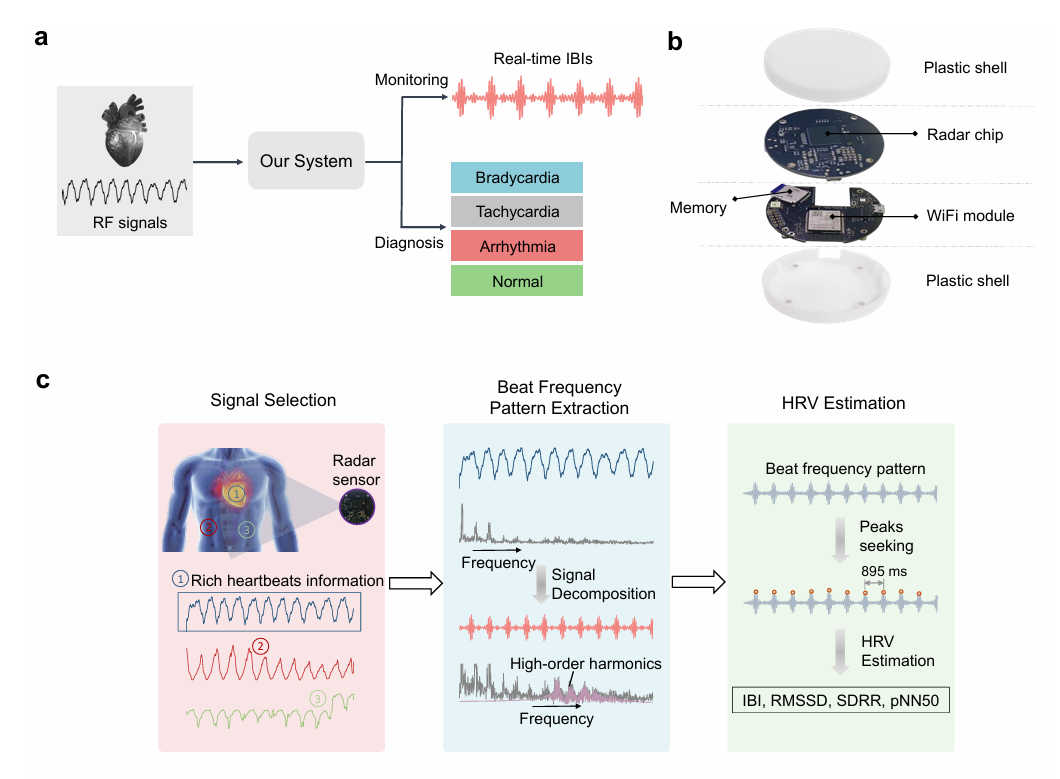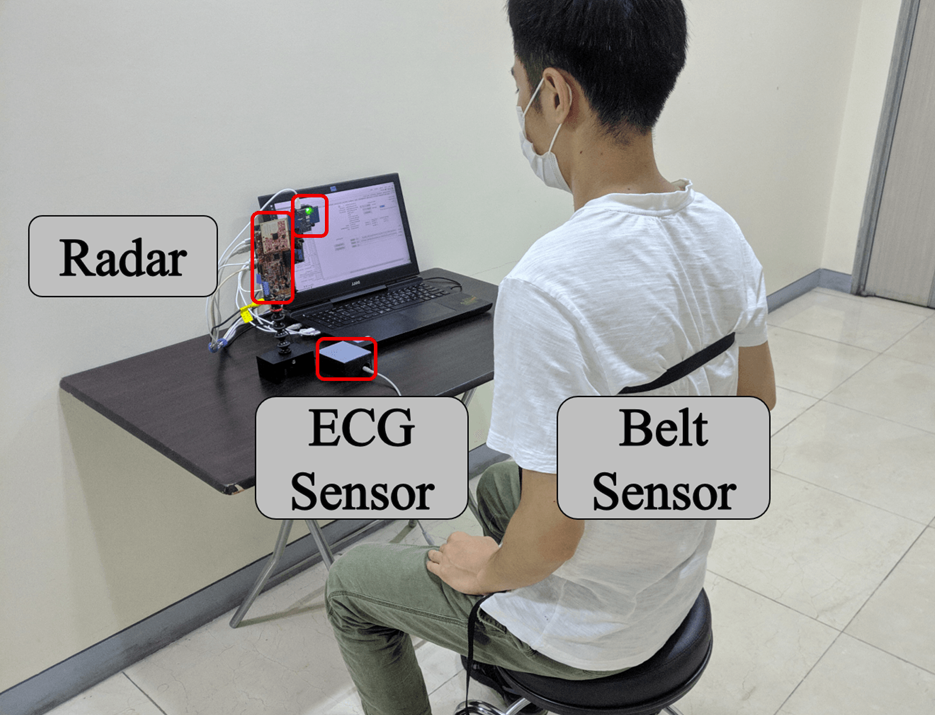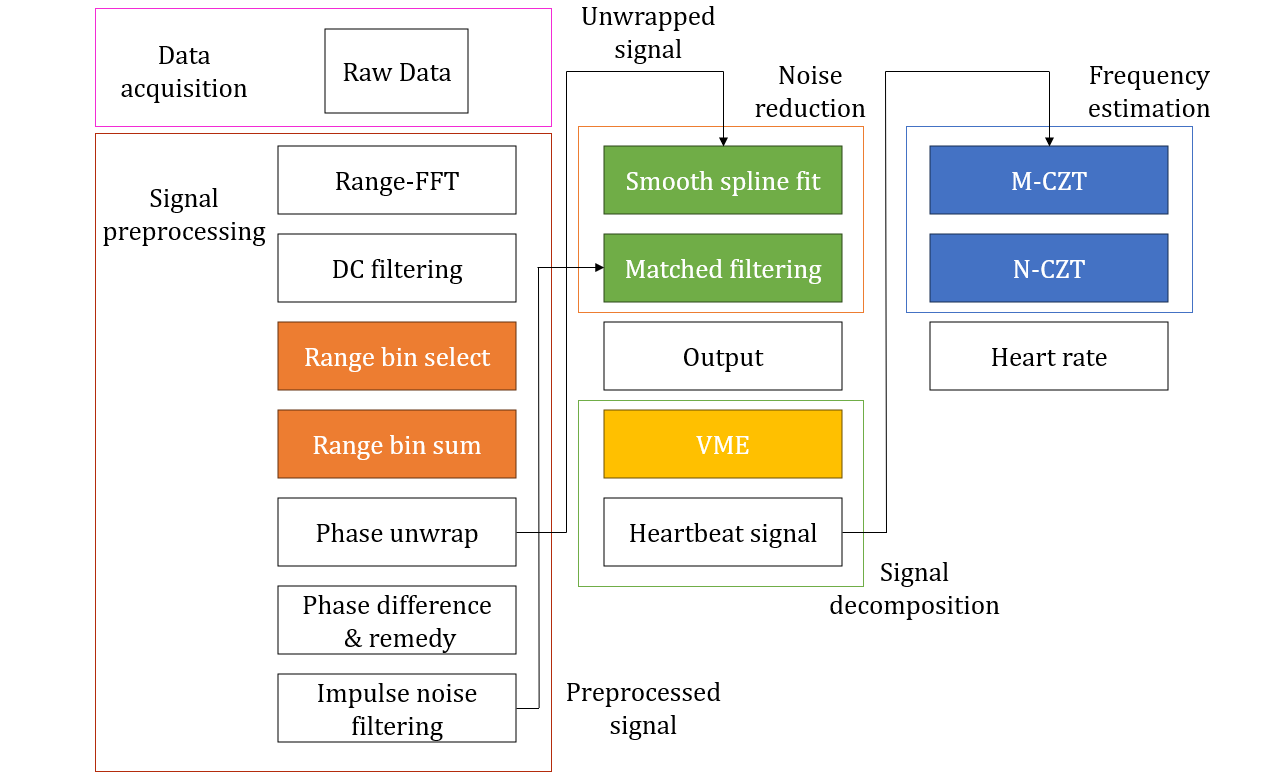FMCW Millimeter-Wave Radar for Non-Contact Cardiopulmonary Monitoring
Overview
Frequency-Modulated Continuous-Wave (FMCW) radar provides a compact, non-contact solution for monitoring cardiopulmonary activity by resolving chest wall displacements at millimeter precision. The central challenge is separating weak heartbeat signals from dominant respiratory motion while suppressing noise and harmonics under realistic conditions. This project develops a full radar–signal processing pipeline to enable accurate extraction of respiration rate (RR) and heart rate (HR).

Experimental Setup
I configured the Texas Instruments IWR1443BOOST FMCW radar together with the DCA1000EVM data capture board via mmWave Studio to acquire raw ADC echoes in multi-chirp frames. Range profiles were resolved using an approximated FFT (apFFT), followed by DC removal, range-bin selection, and phase unwrapping to obtain thoracic displacement waveforms.

Signal Processing Framework
To extract respiration and heartbeat components, I designed a multi-stage pipeline in MATLAB:
- Preprocessing: Applied smoothing-spline fitting to capture and remove slow respiratory trends, and used matched filtering to enhance subtle heartbeat oscillations.
- Variational Mode Extraction (VME): Decomposed displacement signals into intrinsic modes, isolating respiration (~0.2–0.3 Hz) from heartbeat (~1 Hz).
- Double Chirp-Z Transform (double-CZT): Provided high-resolution spectral estimation, surpassing conventional FFT by yielding sharper, better-separated peaks.
Key formulations:
Variational Mode Extraction (VME) minimizes the following cost functional:
\[ \min_{\{u_k,\omega_k\}} \sum_{k=1}^K \left\| \partial_t \left[ \left( \delta(t) + \frac{j}{\pi t} \right) * u_k(t) \cdot e^{-j\omega_k t} \right] \right\|_2^2 \] where \(u_k(t)\) are intrinsic modes and \(\omega_k\) their center frequencies.
The Chirp-Z Transform (CZT) maps a sequence \(x[n]\) to an arbitrary contour in the z-plane:
\[ X_k = \sum_{n=0}^{N-1} x[n] \, z_k^{-n}, \quad z_k = A W^{-k}, \quad k=0,\ldots,M-1 \] where \(A\) and \(W\) control the start point and frequency resolution. A double-CZT applies two successive zoomed analyses for enhanced resolution around respiratory and cardiac bands.

My Contributions
- Configured the IWR1443BOOST FMCW radar with DCA1000EVM and mmWave Studio to acquire raw ADC data for non-contact cardiopulmonary monitoring.
- Implemented apFFT-based range profiling to resolve thoracic reflections from radar chirps.
- Developed advanced preprocessing modules including smoothing-spline fitting and matched filtering to enhance weak heartbeat oscillations.
- Applied Variational Mode Extraction (VME) for robust decomposition of respiratory and cardiac components.
- Performed double-CZT spectral estimation for high-resolution frequency analysis, enabling precise detection of RR and HR.
- Reproduced and validated published benchmark results in MATLAB, confirming the accuracy and robustness of the framework.
Progress & Outlook
The developed pipeline reliably extracted respiration (~0.25 Hz) and heartbeat (~1 Hz) peaks even under low signal-to-noise conditions. Compared with conventional FFT methods, the double-CZT produced sharper and better-isolated peaks, enabling more stable heart-rate tracking across datasets. My contributions spanned radar configuration, advanced preprocessing, VME decomposition, and double-CZT spectral estimation. Looking ahead, I aim to extend the framework toward real-time implementation and validate it under more challenging scenarios such as subject motion and through-obstacle sensing, thereby strengthening the biomedical applicability of FMCW radar technology.